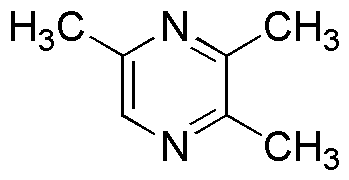2,3,5-Trimethylpyrazine is widely utilized in research focused on:
- Flavoring Agents: This compound is commonly used in the food industry to enhance the aroma and flavor of various products, particularly in savory dishes and snacks.
- Fragrance Industry: It serves as a key ingredient in perfumes and fragrances, providing a warm, nutty scent that is appealing in personal care products.
- Aromatic Compounds in Chemistry: Researchers utilize it as a building block in organic synthesis, contributing to the development of more complex molecules in pharmaceuticals and agrochemicals.
- Food Preservation: Its antioxidant properties can help in extending the shelf life of certain food products, making it valuable for food technologists.
- Research in Sensory Analysis: It is employed in studies examining flavor perception and sensory evaluation, aiding food scientists in understanding consumer preferences.
General Information
Properties
Safety and Regulations
Applications
2,3,5-Trimethylpyrazine is widely utilized in research focused on:
- Flavoring Agents: This compound is commonly used in the food industry to enhance the aroma and flavor of various products, particularly in savory dishes and snacks.
- Fragrance Industry: It serves as a key ingredient in perfumes and fragrances, providing a warm, nutty scent that is appealing in personal care products.
- Aromatic Compounds in Chemistry: Researchers utilize it as a building block in organic synthesis, contributing to the development of more complex molecules in pharmaceuticals and agrochemicals.
- Food Preservation: Its antioxidant properties can help in extending the shelf life of certain food products, making it valuable for food technologists.
- Research in Sensory Analysis: It is employed in studies examining flavor perception and sensory evaluation, aiding food scientists in understanding consumer preferences.
Documents
Safety Data Sheets (SDS)
The SDS provides comprehensive safety information on handling, storage, and disposal of the product.
Product Specification (PS)
The PS provides a comprehensive breakdown of the product’s properties, including chemical composition, physical state, purity, and storage requirements. It also details acceptable quality ranges and the product's intended applications.
Certificates of Analysis (COA)
Search for Certificates of Analysis (COA) by entering the products Lot Number. Lot and Batch Numbers can be found on a product’s label following the words ‘Lot’ or ‘Batch’.
Numéro de catalogue
Numéro de lot/série
Certificates Of Origin (COO)
This COO confirms the country where the product was manufactured, and also details the materials and components used in it and whether it is derived from natural, synthetic, or other specific sources. This certificate may be required for customs, trade, and regulatory compliance.
Numéro de catalogue
Numéro de lot/série
Safety Data Sheets (SDS)
The SDS provides comprehensive safety information on handling, storage, and disposal of the product.
DownloadProduct Specification (PS)
The PS provides a comprehensive breakdown of the product’s properties, including chemical composition, physical state, purity, and storage requirements. It also details acceptable quality ranges and the product's intended applications.
DownloadCertificates of Analysis (COA)
Search for Certificates of Analysis (COA) by entering the products Lot Number. Lot and Batch Numbers can be found on a product’s label following the words ‘Lot’ or ‘Batch’.
Numéro de catalogue
Numéro de lot/série
Certificates Of Origin (COO)
This COO confirms the country where the product was manufactured, and also details the materials and components used in it and whether it is derived from natural, synthetic, or other specific sources. This certificate may be required for customs, trade, and regulatory compliance.


